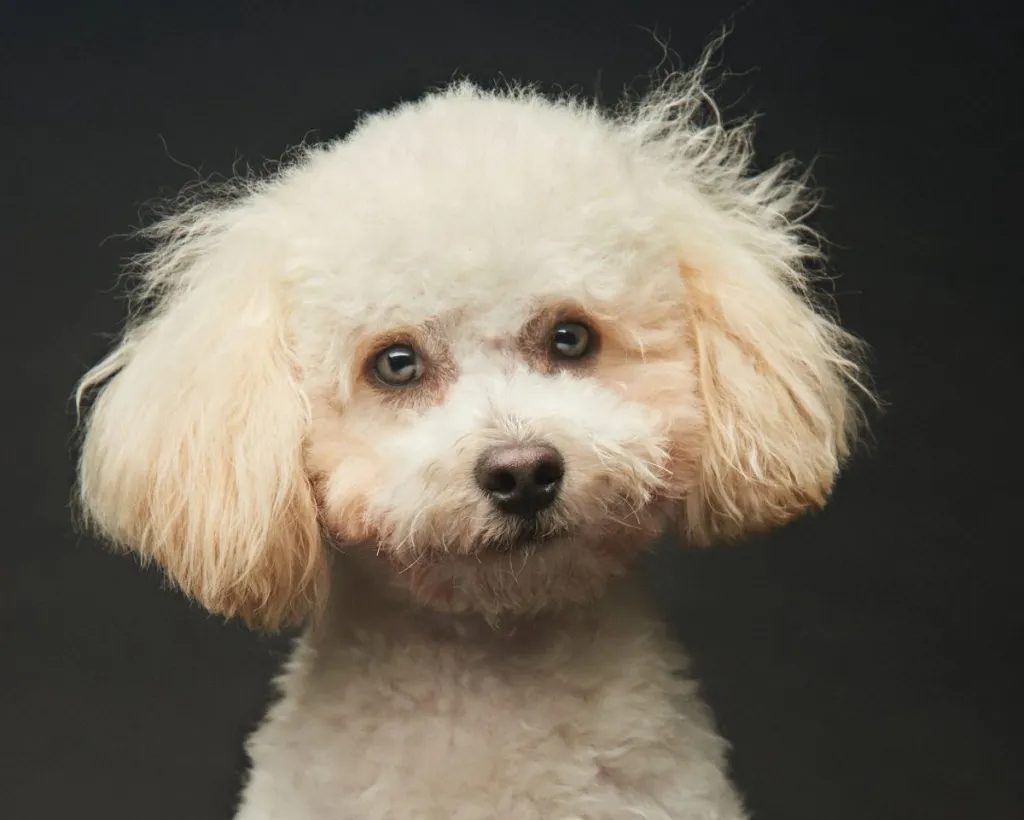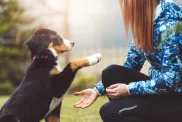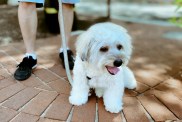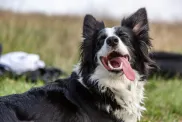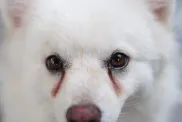The Maltipoo, a popular hybrid breed dog, is a cross between a Maltese and a Poodle. It is known for its adorable appearance, friendly disposition, and hypoallergenic coat.
This active canine has a small yet sturdy build and showcases an array of vibrant coat colors, ranging from creamy white and apricot to chocolate and silver. With its intelligent and trainable nature, the Maltipoo thrives in interactive activities. It quickly grasps commands and performs tricks that never fail to entertain its human companions.
The Maltipoo’s charming and sociable demeanor makes it an ideal companion for families, singles, and seniors alike. This lovable breed relishes in human interaction and eagerly joins in on adventures. Whether it is a playful day in the park or a cozy evening snuggle on the couch, the Maltipoo is game for both.
Quick Facts
- Origin: United States. The goal was to combine the Poodle’s hypoallergenic coat and intelligence with the Maltese’s charm and compact size.
- Breed Group: Hybrid (Designer)
- Size: Small, typically 5-15 pounds (2.3-6.8 kg)
- Lifespan: 10-15 years
- Coat: Maltipoos can have a variety of coat types, including straight, wavy, or curly. They often have low-shedding or hypoallergenic coats, which can vary depending on the generation of the cross.
- Temperament: Maltipoos are known for being affectionate, friendly, and sociable. They often form strong bonds with their families and can get along well with children and other pets.
- Exercise Needs: They have moderate exercise requirements. Regular playtime, walks, and mental stimulation are important for their well-being.
- Training: Maltipoos are usually intelligent and eager to please, making them trainable. Positive reinforcement methods work well with them.
- Grooming: Grooming needs depend on the coat type. Regular brushing and occasional professional grooming help keep their coat in good condition.
- Health: Maltipoos can inherit health traits from both parent breeds. Responsible breeding practices, regular veterinary care, and a balanced diet are important for their overall health.
- Malitpoos are a favorite of celebrities with Rihanna, Blake Lively, and Miley Cyrus all parents to this adorable breed.
RELATED: Maltipoo Puppies: Cute Pictures & Facts
Maltipoo Mixed Dog Breed Pictures
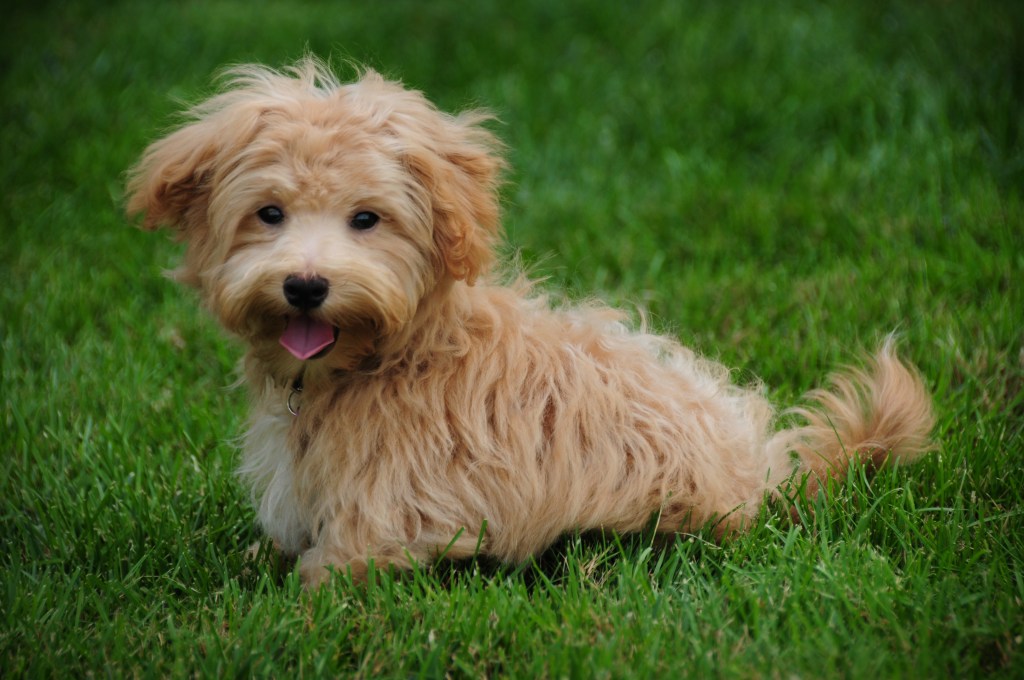
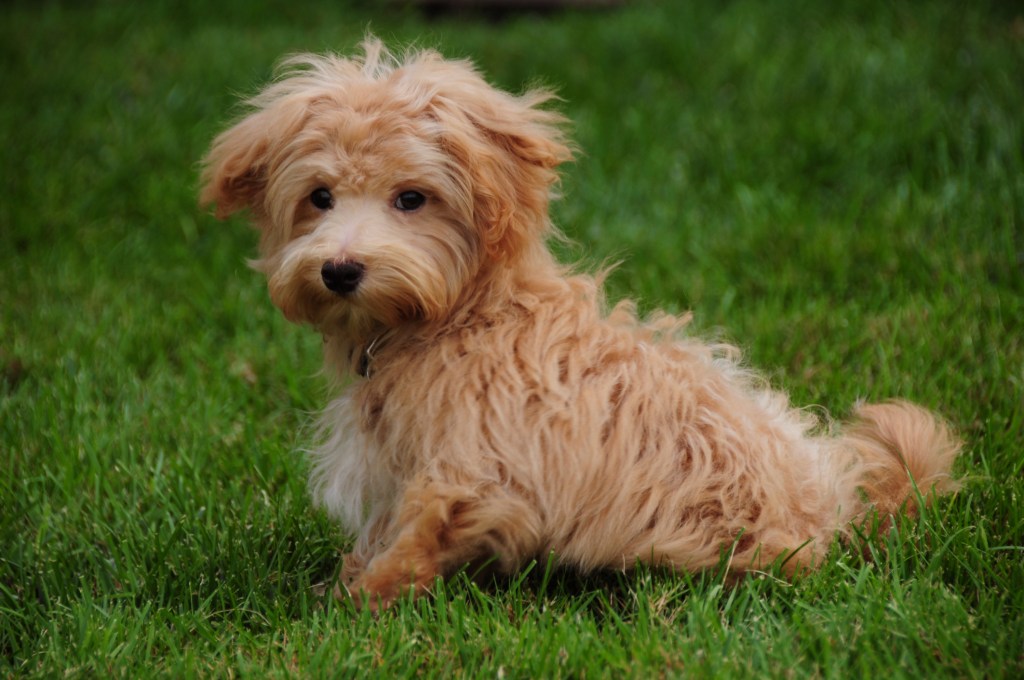
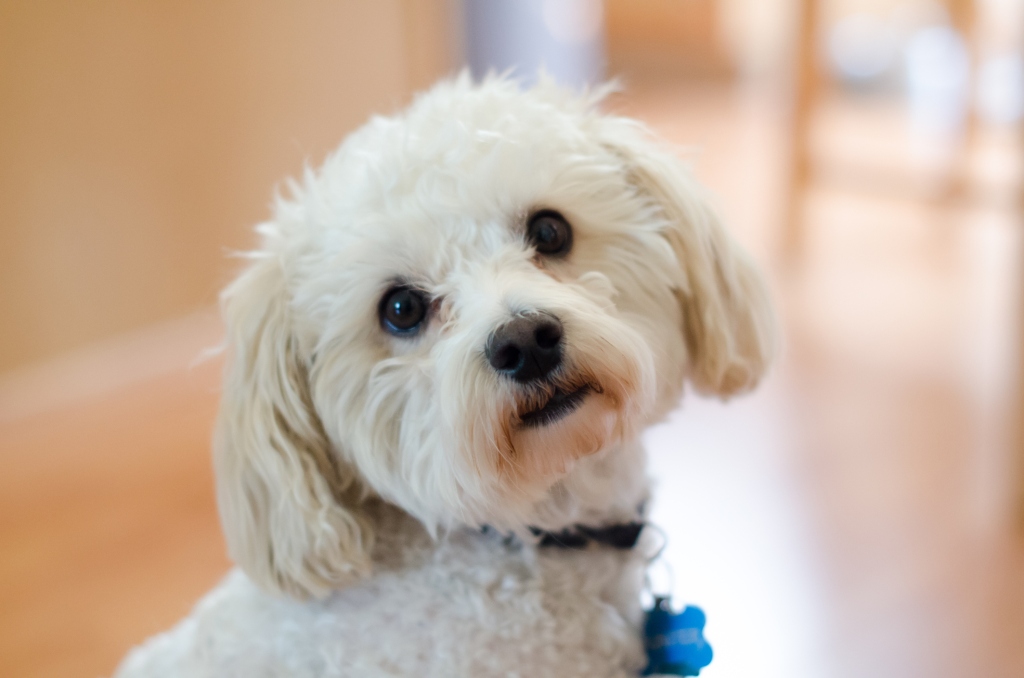
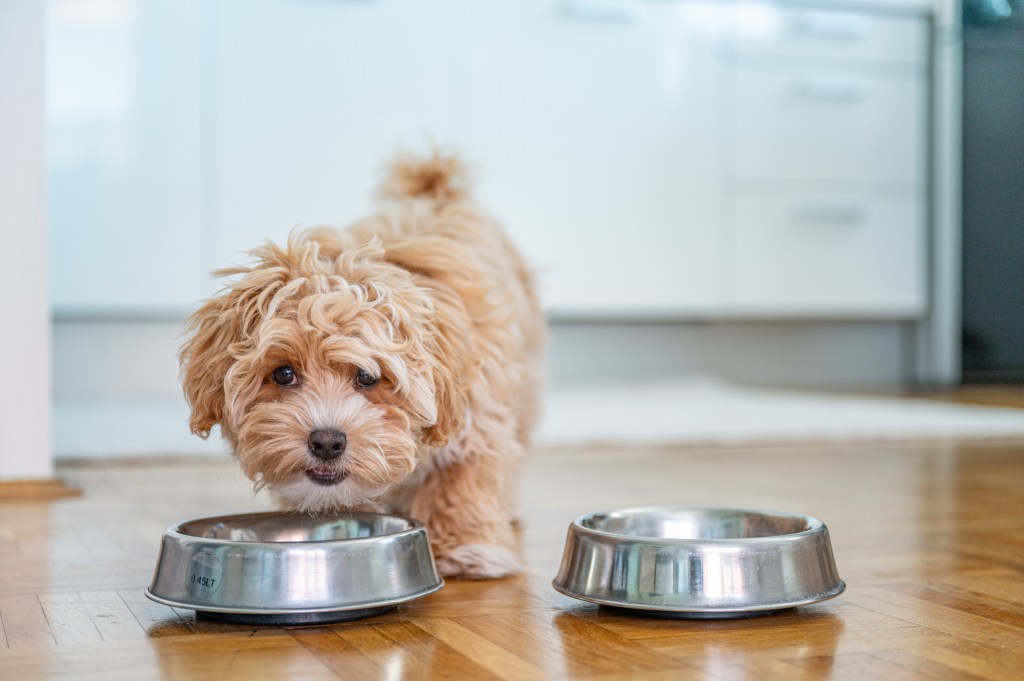

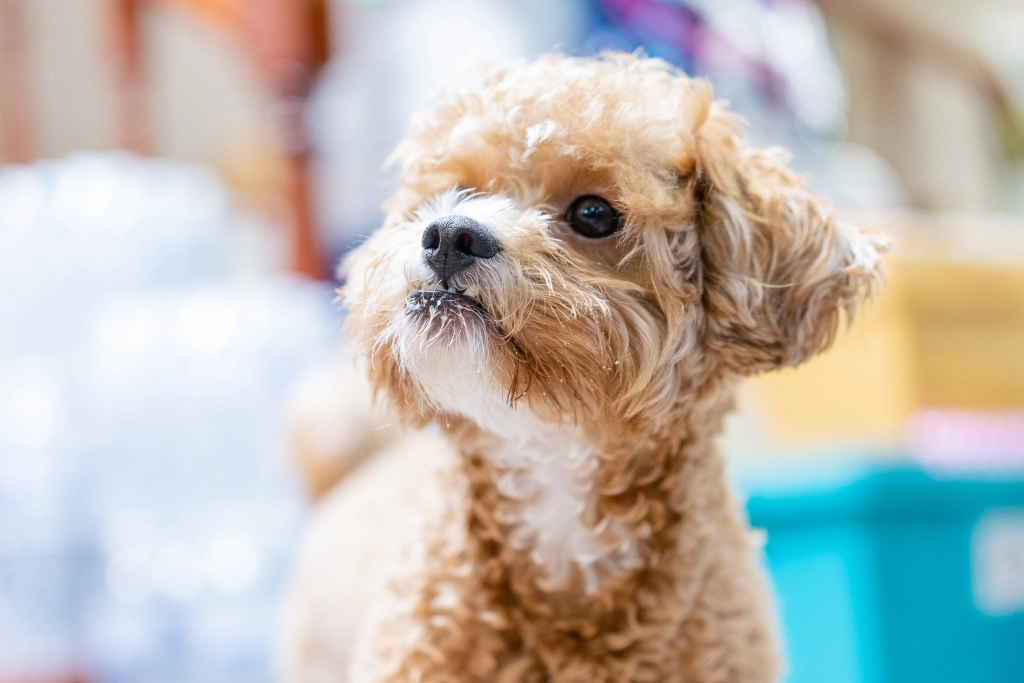
Adaptability
-
Adapts Well To Apartment Living
Looking for the best dog for your apartment? Contrary to popular belief, the suitability of dogs who adapt well to apartment living goes beyond its size. Apartment dwellers have a myriad of dog breeds to choose from as potential companions, with various factors to consider. Some large breeds can adapt well to apartment living and have lower activity levels. Others may require more space and possess higher energy levels. On the other hand, certain small dog breeds with abundant energy can still find contentment with indoor playtime or brisk walks.
However, when selecting a dog that adapts well apartments, it is essential to prioritize your neighbors. Opting for a pet that doesn’t excessively bark and behaves politely when encountering others in shared spaces like is crucial for maintaining a harmonious apartment environment.
In high-rise settings, it’s worth noting that numerous small dogs may exhibit a propensity for high energy and frequent barking. This makes them less suitable for apartment living. Therefore, desirable qualities in an apartment dog encompass being quiet, low-energy, and displaying polite behavior towards other residents.
Factors To Consider When Choosing A Dog For An Apartment
When considering dogs that adapt well to apartments, size alone should not be the sole determinant. Apartment dwellers have a wealth of dog breeds to choose from as potential furry companions. It’s important to remember that the size of your living space is just one factor to consider. While some larger breeds can adapt well to apartment living, with lower, others may require more space and have higher energy levels, making them less suitable for smaller apartments. Conversely, certain small dog breeds with higher energy levels can still thrive in apartments, finding contentment through indoor playtime or brisk walks. However, it is crucial to consider your neighbors’ comfort when selecting a dog. Opt for a pet that doesn’t bark excessively and behaves politely when interacting with others in shared spaces.
Therefore, it’s important to prioritize qualities such as being quiet, low-energy, calm indoors, and exhibiting good manners when living in close proximity to other residents. By considering these factors, you can find a dog that will adapt well to apartment living and create a harmonious living environment for everyone involved.
-
Good For Novice Owners
Some dogs are simply easier than others; they take to training better and are fairly easygoing. They’re also resilient enough to bounce back from your mistakes or inconsistencies.
Dogs who are highly sensitive, independent thinking, or assertive may be harder for a first-time dog parent to manage. You’ll get your best match if you take your dog-owning experience into account as you choose your new pooch.
If you’re new to dog parenting, take a look at 101 Dog Tricks and read up on how to train your dog!
-
Sensitivity Level
Some dogs will let a stern reprimand roll off their backs, while others take even a dirty look to heart. Low-sensitivity dogs, also called “easygoing,” “tolerant,” “resilient,” and even “thick-skinned,” can better handle a noisy, chaotic household, a louder or more assertive owner, and an inconsistent or variable routine. Do you have young kids, throw lots of dinner parties, play in a garage band, or lead a hectic life? Go with a low-sensitivity dog.
-
Tolerates Being Alone
Some breeds bond very closely with their family and are more prone to worry or even panic when left alone by their owner. An anxious dog can be very destructive–barking, whining, chewing, and otherwise causing mayhem. These breeds do best when a family member is home during the day or if you can take the dog to work.
-
Tolerates Cold Weather
Breeds with very short coats and little or no undercoat or body fat, such as Greyhounds, are vulnerable to the cold. Dogs with a low cold tolerance need to live inside in cool climates and should have a jacket or sweater for chilly walks. You can find a great jacket for your dog here!
-
Tolerates Hot Weather
Dogs with thick, double coats are more vulnerable to overheating. So are breeds with short noses, like Bulldogs or Pugs, since they can’t pant as well to cool themselves off. If you want a heat-sensitive breed, your dog will need to stay indoors with you on warm or humid days, and you’ll need to be extra cautious about exercising your dog in the heat.
All-around friendliness
-
Affectionate With Family
When it comes to unconditional love and unwavering loyalty, few animals can rival the affectionate nature of dogs. These remarkable creatures have earned their reputation as man’s best friend, and many breeds are particularly renowned for their love and devotion to their families. With their warm hearts and wagging tails, affectionate family dogs enrich the lives of their owners in countless ways.
One such breed known for its affectionate demeanor is the Golden Retriever. With their gentle temperament and friendly disposition, Golden Retrievers form deep bonds with their families. They eagerly participate in family activities, whether it’s a game of fetch in the yard or cuddling on the couch during a movie night. Their expressive eyes and ever-wagging tails are a testament to the joy they feel in the presence of their loved ones.
Another family-favorite breed is the Labrador Retriever. Renowned for their playful and patient nature, Labradors are excellent companions for children and adults alike. They readily engage in playtime with the kids, showcasing their boundless energy and enthusiasm. But when the day winds down, they seamlessly transition into loving and gentle cuddle buddies, comforting their family members with their warm presence.
Beyond specific breeds, mixed-breed dogs also have a special place in the hearts of families seeking affectionate companions. The shelter dogs, in particular, form deep connections with their adoptive families. They seem to understand the second chance they’ve been given and repay it with endless love and gratitude.
How To Know If A Dog Is Good With Families
The affectionate nature of family dogs extends beyond play and cuddles. Dogs have a remarkable ability to sense their owner’s emotions, offering comfort and support during difficult times. Whether it’s a wagging tail after a long day at work or a sympathetic nuzzle during moments of sadness, they prove time and again that they are attuned to their family’s needs.
It is important to note that not all dogs of the same breed will be equally affectionate. Some dogs may be more independent or aloof, while others may be more clingy or demanding of attention. The best way to find out how affectionate a dog is is to meet them in person and interact with them.
-
Kid-Friendly
Being gentle with children, sturdy enough to handle the heavy-handed pets and hugs they can dish out, and having a blasé attitude toward running, screaming children are all traits that make a kid-friendly dog. You may be surprised by who’s on that list: Fierce-looking Boxers are considered good with children, as are American Staffordshire Terriers (which are considered Pit Bulls). Small, delicate, and potentially snappy dogs such as Chihuahuas aren’t always so family-friendly.
**All dogs are individuals. Our ratings are generalizations, and they’re not a guarantee of how any breed or individual dog will behave. Dogs from any breed can be good with children based on their past experiences, training on how to get along with kids, and personality. No matter what the breed or breed type, all dogs have strong jaws, sharp pointy teeth, and may bite in stressful circumstances. Young children and dogs of any breed should always be supervised by an adult and never left alone together, period.
-
Dog Friendly
Friendliness toward dogs and friendliness toward humans are two completely different things. Some dogs may attack or try to dominate other dogs, even if they’re love-bugs with people; others would rather play than fight; and some will turn tail and run. Breed isn’t the only factor. Dogs who lived with their littermates and mother until at least six to eight weeks of age and who spent lots of time playing with other dogs during puppyhood, are more likely to have good canine social skills.
-
Friendly Toward Strangers
Stranger-friendly dogs will greet guests with wagging tails and nuzzles; others are shy, indifferent, or even aggressive. However, no matter what the breed, a dog who was socialized and exposed to lots of different types, ages, sizes, and shapes of people as a puppy will respond better to strangers as an adult. Remember that even friendly dogs should stay on a good, strong leash like this one in public!
Health And Grooming Needs
-
Amount Of Shedding
If you’re going to share your home with a dog, you’ll need to deal with some level of dog hair on your clothes and in your house. However, shedding does vary greatly among the breeds. Some dogs shed year-round, some “blow” seasonally, some do both, and some shed hardly at all. If you’re a neatnik, you’ll need to either pick a low-shedding breed or relax your standards. To help keep your home a little cleaner, you can find a great de-shedding tool here!
-
Drooling Potential
Drool-prone dogs may drape ropes of slobber on your arm and leave big, wet spots on your clothes when they come over to say hello. If you’ve got a laid-back attitude toward slobber, fine; but if you’re a neatnik, you may want to choose a dog who rates low in the drool department.
-
Easy To Groom
Some breeds are brush-and-go dogs; others require regular bathing, clipping, and other grooming just to stay clean and healthy. Consider whether you have the time and patience for a dog who needs a lot of grooming, or the money to pay someone else to do it.
-
General Health
Due to poor breeding practices, some breeds are prone to certain genetic health problems, such as hip dysplasia. This doesn’t mean that every dog of that breed will develop those diseases; it just means that they’re at an increased risk.
If you’re adopting a puppy, it’s a good idea to find out which genetic illnesses are common to the breed you’re interested in. You may also want to ask if your shelter or rescue has information about the physical health of your potential pup’s parents and other relatives.
-
Potential For Weight Gain
Some breeds have hearty appetites and tend to put on weight easily. As in humans, being overweight can cause health problems in dogs. If you pick a breed that’s prone to packing on pounds, you’ll need to limit treats, make sure they get enough exercise, and measure out their daily food servings into regular meals rather than leaving food out all the time.
Ask your vet about your dog’s diet and what they recommend for feeding your pooch to keep them at a healthy weight. Weight gain can lead to other health issues or worsen problems like arthritis.
-
Size
Get ready to meet the giants of the doggy world! Large dog breeds aren’t just big balls of fluff, they’re like loving, oversized teddy bears on a mission to steal your heart. Need some convincing? Let’s dive into the awesome benefits of owning one!
First things first, these pooches are a living security system! With their impressive size and thunderous barks, they’ll have any would-be intruder running for the hills. Talk about peace of mind! Plus, who needs an alarm when you’ve got a furry giant protecting your castle?
But that’s not all. Large dog breeds are all about loyalty and devotion. They’ll stick by your side through thick and thin, becoming your most dedicated bestie. Their love knows no bounds! When you have a giant fluffball showing you unconditional love, you’ll feel like the luckiest human on the planet.
Now, let’s talk about their talents. These big fellas are the ultimate working partners. With brains and brawn, they’re up for any challenge. From search and rescue missions to lending a helping paw to those in need, these dogs are superheroes in fur coats. They’ll make you proud every step of the way!
Don’t let their size fool you—these gentle giants have hearts as big as their paws. They’re incredible with kids and other pets, spreading their love like confetti. Their patience and kindness make them perfect family pets, ensuring harmony in your household.
Oh, and get ready to break a sweat! These dogs are fitness enthusiasts, and they’ll keep you on your toes. Daily walks, jogs, and play sessions will not only keep them happy and healthy but will also give you a reason to ditch the couch and join in on the fun. It’s a win-win situation!
So, if you’re ready for a dose of big love, go ahead and consider a large dog breed. They’re the best wing-dog you could ever ask for, ready to make your life a thousand times more exciting, loving, and downright awesome! Get ready for the big adventure of a lifetime!
Trainability
-
Easy To Train
Easy-to-train dogs are more adept at forming an association between a prompt (such as the word “sit”), an action (sitting), and a consequence (getting a treat) very quickly. Other dogs need more time, patience, and repetition during training.
Many breeds are intelligent but approach training with a “What’s in it for me?” attitude, in which case you’ll need to use rewards and games to teach them to want to comply with your requests.
Related:
10 Fun, Impressive Tricks You Can Teach Any Dog
-
Intelligence
Dogs who were bred for jobs that require decision making, intelligence, and concentration, such as herding livestock, need to exercise their brains, just as dogs who were bred to run all day need to exercise their bodies. If they don’t get the mental stimulation they need, they’ll make their own work–usually with projects you won’t like, such as digging and chewing. Obedience training and interactive dog toys are good ways to give a dog a brain workout, as are dog sports and careers, such as agility and search and rescue.
-
Potential For Mouthiness
Common in most breeds during puppyhood and in Retriever breeds at all ages, mouthiness means a tendency to nip, chew, and play-bite (a soft, fairly painless bite that doesn’t puncture the skin). Mouthy dogs are more likely to use their mouths to hold or “herd” their human family members, and they need training to learn that it’s fine to gnaw on chew toys, but not on people. Mouthy breeds tend to really enjoy a game of fetch, as well as a good chew on a toy that’s been stuffed with kibble and treats.
-
Prey Drive
Dogs with a high prey drive have an instinctive desire to stalk, capture, and prey upon potential food sources. Dogs who were bred to hunt, such as Terriers, have an inborn desire to chase — and sometimes kill — other animals. Anything whizzing by — such as cats, squirrels, and perhaps even cars — can trigger that instinct.
How to address a high prey drive
Off-leash adventures are too great a temptation for pups who will wander and hunt. Dogs who like to chase need to be leashed. And, even on a leash, you may experience your dog pulling on the leash to reach rodents or birds in their sight. Otherwise, these pups should be kept in a fenced area when outdoors. If your pup has a high prey drive, you’ll need a high, secure fence in your yard.
These breeds generally aren’t a good fit for homes with smaller pets that can look like prey, such as cats, hamsters, or small dogs. Breeds that were originally used for bird hunting, on the other hand, generally won’t chase, but you’ll probably have a hard time getting their attention when there are birds flying by.
Other behavioral concerns
Observing your dog’s prey drive, which is instinctual and biologically-rooted, is not the same as observing aggression. Much aggression is born of fear and anxiety, especially in the case of dog aggression toward humans.
The tendency to wander, even into oncoming traffic, can produce diasterious results for pups with predatory instincts. It can also lead to pups being bitten by snakes or attacked by other wild animals they may pursue while on the hunt.
-
Tendency To Bark Or Howl
Some breeds sound off more often than others. When choosing a breed, think about how often the dog vocalizes. Learn more about breeds with a tendency to bark or howl.
If you’re considering a hound, would you find their trademark howls musical or maddening? If you’re considering a watchdog, will a city full of suspicious “strangers” put your pup on permanent alert? Will the local wildlife literally drive your dog wild? Do you live in housing with noise restrictions? Do you have neighbors nearby? Then you may wish to choose a quieter dog.
-
Wanderlust Potential
Some breeds are more free-spirited than others. Nordic dogs such as Siberian Huskies were bred to range long distances, and given the chance, they’ll take off after anything that catches their interest. And many hounds simply must follow their noses–or that bunny that just ran across the path–even if it means leaving you behind.
Exercise needs
-
Energy Level
High-energy dogs are always ready and waiting for action. Originally bred to perform a canine job of some sort, such as retrieving game for hunters or herding livestock, they have the stamina to put in a full workday. They need a significant amount of exercise and mental stimulation, and they’re more likely to spend time jumping, playing, and investigating any new sights and smells.
Low-energy dogs are the canine equivalent of a couch potato, content to doze the day away. When picking a breed, consider your own activity level and lifestyle, and think about whether you’ll find a frisky, energetic dog invigorating or annoying.
-
Intensity
A vigorous dog may or may not have high energy, but everything they do, they do with vigor: they strain on the leash (until you train them not to), try to plow through obstacles, and even eats and drinks with great big gulps. These dynamos need lots of training to learn good manners, and may not be the best fit for a home with young kids or someone who’s elderly or frail. A low-vigor dog, on the other hand, has a more subdued approach to life.
-
Exercise Needs
Some breeds do fine with a slow evening stroll around the block. Others need daily, vigorous exercise, especially those that were originally bred for physically demanding jobs, like herding or hunting.
Without enough exercise, these breeds may put on weight and vent their pent-up energy in ways you don’t like, such as barking, chewing, and digging. Breeds that need a lot of exercise are good for outdoorsy, active people, or those interested in training their dog to compete in a high-energy dog sport, such as agility.
-
Potential For Playfulness
Some dogs are perpetual puppies — always begging for a game — while others are more serious and sedate. Although a playful pup sounds endearing, consider how many games of fetch or tag you want to play each day, and whether you have kids or other dogs who can stand in as playmates for the dog.
Maltipoo Overview
Maltipoos are a popular cross of the Maltese and Toy or Miniature Poodle. True to their parent breeds, Maltipoos are affectionate and gentle. They make super companions for empty-nesters and are excellent therapy dogs. Cross breeds such as the Maltipoo are often referred to as designer dogs, rather than mixed breeds, because they’re purposely bred and are a combination of two known breeds.
Because both Poodles and Maltese are considered non-shedders, people who breed Maltipoos hope to end up with a hypoallergenic dog. If you’re allergic, however, it’s important to know a little something about pet allergies before you run out to get a Maltipoo.
All dogs produce dander (dead skin flakes) and saliva, which carry allergens. And allergies can build over time. You may not react to a dog when you first meet him, but develop an allergy after living with him for days, weeks, or even months. Spend lots of time with a number of different Maltipoos to see how you’ll react. If you decide that a Maltipoo is for you, you’ll find that he’s an active, feisty, fun-loving dog.
He enjoys life, and his perfect day includes playing dog games, going for a walk, and racing through the house. Maltipoos can be a good choice for first-time or timid owners. They’re easy to train and learn quickly. They also do well in homes with elderly people or with older children who can handle them carefully.
They enjoy long cuddles and are sensitive to their people’s wants and needs. Maltipoos can adapt to any kind of home, from an apartment to a house. No matter what their housing, they love being with their people, and should live indoors with their human families, never outside or in kennels. They’re not recommended for homes where they’ll be left alone for long periods. Maltipoos can be barkers and will alert you to everything that’s going on. You may need to work hard to teach them to discriminate between what’s important to bark at and what’s not. Maltipoos are fun-loving, happy dogs who’ve stolen many hearts. For those who appreciate their cuddly appeal and can give them the companionship they need, they can make an ideal pet.
Maltipoo Highlights
Adorable Crossbreed: The Maltipoo is a charming and popular crossbreed that combines the best traits of the Maltese and the Poodle.
Hypoallergenic Coat: Known for their low-shedding and hypoallergenic coat, Maltipoos are often a good choice for individuals with allergies.
Compact Size: Maltipoos are small-sized dogs, making them well-suited for apartment living and households with limited space.
Companion Nature: These dogs thrive on companionship and are known for forming strong bonds with their families. They are affectionate and enjoy being around people.
Intelligence: Maltipoos inherit intelligence from both parent breeds, making them quick learners and adaptable to various training commands.
Playful and Social: Maltipoos have a playful and friendly demeanor, making them enjoyable companions for families, singles, and seniors alike.
Moderate Exercise Needs: While they have energy to expend, Maltipoos don’t require extensive exercise. Regular walks and play sessions are usually enough to keep them content.
Training Potential: Due to their intelligence and eagerness to please, Maltipoos are often successful in obedience training and can learn tricks quickly.
Grooming: Their coat requires regular grooming to prevent matting, but their low-shedding nature reduces the amount of hair in the environment.
Long Lifespan: Maltipoos enjoy a relatively long lifespan for a small breed, often living between 10 to 15 years.
Versatile Compatibility: Whether in a family setting, with singles, or with seniors, Maltipoos adapt well to their owners’ lifestyles.
Remember that each individual Maltipoo can have its own unique personality and characteristics, so spending time with a breed representative is essential to understanding if they’re the right fit for your lifestyle and preferences.
Maltipoo History
The Maltipoo was created to be a small-breed companion dog for allergy sufferers. Whether he’s really hypoallergenic is up for debate; every dog is different in the amount of allergens he produces, but in any case, he’s a charming ball of fluff with a growing popularity.
Maltipoos have enjoyed the affections of celebrities and are among the more popular of the so-called designer breeds. Most litters are the result of first-generation breedings between Maltese and Poodles, but some people also breed Maltipoos to Maltipoos. The Maltipoo is not officially recognized as a true breed, but fans have formed the North American Maltipoo/Maltepoo Club and Registry.
Maltipoo Size
The Maltipoo varies in size, depending on whether the Poodle parent was a Toy or Miniature. Generally, Maltipoos stand 8 to 14 inches tall and weigh 5 to 20 pounds.
Maltipoo Personality
This is an intelligent, affectionate, fun-loving dog who generally gets along well with everyone he meets. Gentle and devoted, Maltipoos enjoy spending their days perched on their owner’s laps or walking beside them. They can also be active and feisty, and enjoy a good play session just as much as they relish a long cuddle.
They’re alert and make excellent alarm dogs, but don’t count on them to provide any kind of protection. Like all dogs, Maltipoos need early socialization — exposure to many different people, sights, sounds, and experiences — when they’re young. Socialization helps ensure that your Maltipoo puppy grows up to be a well-rounded dog.
Maltipoo Health
Not all Maltipoos will get any or all of these diseases, but it’s important to be aware of them if you’re considering this crossbreed.
- White Shaker Syndrome manifests as tremors over the entire body, lack of coordination, and rapid eye movements. Episodes usually start when the dog is six months to three years old and is stressed or overly excited. This condition isn’t painful and doesn’t affect the dog’s personality. If you suspect your Maltipoo has White Dog Shaker Syndrome, talk to your vet about treatment options.
- Epilepsy causes seizures in the dog. Epilepsy can be managed with medication, but it cannot be cured. A dog can live a full and healthy life with the proper management of this disorder, which can be hereditary or of unknown cause.
- Patellar Luxation, also known as “slipped stifles,” is a common problem in small dogs. It is caused when the patella, which has three parts-the femur (thigh bone), patella (knee cap), and tibia (calf)-is not properly lined up. This causes lameness in the leg or an abnormal gait, sort of like a skip or a hop. It is a condition that is present at birth although the actual misalignment or luxation does not always occur until much later. The rubbing caused by patellar luxation can lead to arthritis, a degenerative joint disease. There are four grades of patellar luxation, ranging from grade I, an occasional luxation causing temporary lameness in the joint, to grade IV, in which the turning of the tibia is severe and the patella cannot be realigned manually. This gives the dog a bowlegged appearance. Severe grades of patellar luxation may require surgical repair.
- Portosystemic Shunt (PSS) is an abnormal flow of blood between the liver and the body. That’s a problem, because the liver is responsible for detoxifying the body, metabolizing nutrients, and eliminating drugs. Signs can include but are not limited to neurobehavioral abnormalities such as poor balance, lack of appetite, hypoglycemia (low blood sugar), intermittent gastrointestinal issues, loss of appetite, urinary tract problems, drug intolerance, and stunted growth. Signs usually appear before two years of age. Corrective surgery can be helpful in long-term management, as can a special diet.
- Progressive Retinal Atrophy (PRA) is a degenerative eye disorder that eventually causes blindness from the loss of photoreceptors at the back of the eye. PRA is detectable years before the dog shows any signs of blindness. Fortunately, dogs can use their other senses to compensate for blindness, and a blind dog can live a full and happy life. Just don’t make it a habit to move the furniture around. Reputable breeders have their dogs’ eyes certified annually by a veterinary ophthalmologist and do not breed dogs with this disease.
- Legg-Calve-Perthes Disease affects many toy breeds. When your Maltipoo has Legg-Perthes, the blood supply to the head of the femur (the large rear leg bone) is decreased, and the head of the femur, which connects to the pelvis, begins to disintegrate. Usually, the first signs of Legg-Perthes, limping and atrophy of the leg muscle, occur when puppies are 4 to 6 months old. The condition can be corrected with surgery to cut off the diseased femur so that it isn’t attached to the pelvis any longer. The scar tissue that results from the surgery creates a false joint and the puppy is usually pain free. Prognosis is generally very good after the surgery and many dogs suffer only minor lameness, particularly during weather changes.
Before buying a Maltipoo, it’s important to research the health concerns that affect both the Maltese and the Poodle. Both parents should have health clearances from the Orthopedic Foundation for Animals for patellas (knees) and thyroid and from the Canine Eye Registry Foundation (CERF) certifying that the eyes are normal, including a DNA test for progressive retinal atrophy (PRA). Because some health problems don’t appear until a dog reaches full maturity, health clearances aren’t issued to dogs younger than 2 years old. Look for a breeder who doesn’t breed her dogs until they’re two or three years old.
Maltipoo Care
Maltipoos are people lovers and should live indoors with their family, never outside or in a kennel. They make fine apartment dogs so long as they get daily exercise and aren’t allowed to become nuisance barkers. The Maltipoo is an intelligent dog and takes well to training. Use positive reinforcement techniques such as food rewards, play, and praise, and you’ll be successful in no time.
Maltipoos are active, and they need daily exercise to stay healthy, happy, and out of trouble. Excess energy can lead to destructive behavior, and you might be shocked to know just how much damage a small, bored dog can do. Give your Maltipoo 10 to 15 minutes of exercise each day. A short walk, play sessions in a fenced yard, or a good game of fetch down a hallway will do the trick. Maltipoos can be noisy and will alert bark when they see something or someone that looks suspect. Take this trait into consideration before getting a Maltipoo, especially if you live in a building with noise restrictions.
Maltipoo Feeding
Recommended daily amount: 5/8 to 1.5 cups of a high-quality dog food daily, divided into two meals. How much your adult dog eats depends on his size, age, build, metabolism, and activity level. Dogs are individuals, just like people, and they don’t all need the same amount of food. It almost goes without saying that a highly active dog will need more than a couch potato dog.
The quality of dog food you buy also makes a difference — the better the dog food, the further it will go toward nourishing your dog and the less of it you’ll need to shake into your dog’s bowl. Keep your Maltipoo in good shape by measuring his food and feeding him twice a day rather than leaving food out all the time. If you’re unsure whether he’s overweight, give him the eye test and the hands-on test.
First, look down at him. You should be able to see a waist. Then place your hands on his back, thumbs along the spine, with the fingers spread downward. You should be able to feel but not see his ribs without having to press hard. If you can’t, he needs less food and more exercise. For more on feeding your Maltipoo, see our guidelines for buying the right food, feeding your puppy, and feeding your adult dog.
Maltipoo Coat Color And Grooming
The Maltipoo has a low-shedding, low-dander coat with a fluffy, soft, wool-like texture. It’s medium to long in length, and ranges from slightly wavy to curly. The coat comes in a variety of colors, with the more common colors being cream, white, and silver.
The Maltipoo needs daily brushing to keep his coat clean and free of mats. Many Maltipoos are clipped to keep them tidy and cool. Generally a Maltipoo only needs clipping once or twice a year, but his head will need a monthly trim. Expect to bathe a Maltipoo at least once a month to keep the coat soft and clean.
Trim the hair around the eyes to keep it looking neat. Ears should also be kept clean since they’ll trap dirt, debris, and moisture. Other grooming needs include dental hygiene and nail care. Brush your Maltipoo’s teeth at least two or three times a week to remove tartar buildup and bacteria. Daily is better.
Trim his nails once or twice a month, as needed. If you can hear the nail clicking on the floor, they’re too long. Short nails keep the feet in good condition and won’t scratch your legs when your Maltipoo jumps up to greet you.
Start grooming your Maltipoo when he’s a puppy, to get him used to it. Handle his paws frequently — dogs are touchy about their feet — and look inside his mouth and ears. Make grooming a positive experience filled with praise and rewards, and you’ll lay the groundwork for easy veterinary exams and other handling when he’s an adult.
Maltipoo Children And Other Pets
The Maltipoo is a social dog and gets along well with children. Small Maltipoos aren’t suited to homes with kids younger than 6 years old, however, as they can be easily injured.
As with any dog, always teach children how to approach and touch your Maltipoo, and supervise any interactions between dogs and young children to prevent any biting or ear pulling from either party.
Maltipoos generally get along with other dogs and pets, whether or not they’re raised with them.
Maltipoo Rescue Groups
This cross is frequently available at animal shelters. If you’re interested in adopting a Maltipoo, check your local shelter or the following rescue groups:
Maltipoo Breed Organizations
Finding a reputable dog breeder is one of the most important decisions you will make when bringing a new dog into your life. Reputable breeders are committed to breeding healthy, well-socialized puppies that will make great companions. They will screen their breeding stock for health problems, socialize their puppies from a young age, and provide you with lifetime support.
On the other hand, backyard breeders are more interested in making a profit than in producing healthy, well-adjusted dogs. They may not screen their breeding stock for health problems, and they may not socialize their puppies properly. As a result, puppies from backyard breeders are more likely to have both health and behavioral issues.
